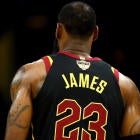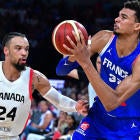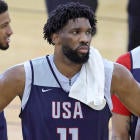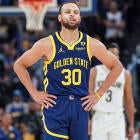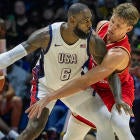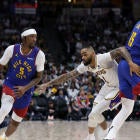LeBron James is officially off the market. The superstar announced on Sunday that he will be taking his talents to Los Angeles to play with the Lakers next season. The LeBron domino has fallen, along with Paul George, Chris Paul and Kevin Durant, but there's still plenty more in store.
Just as a refresher, here's some key information about the upcoming NBA free agency period.
When did free agency start?
Sunday, July 1 at 12:01 a.m. ET was the beginning of NBA free agency, and players are free to meet with teams to discuss terms on a potential contract. However, no free agents can actually sign any contracts (with a few exceptions) until noon ET on July 6. Why? We'll explain below.
What is the July Moratorium?
No contracts can be signed during the negotiation period between July 1 and July 6. This rule was presumably put in place to allow both players and teams to fully think through their decisions before putting pen to paper.
What kinds of signings can take place during the Moratorium?
There are a few contracts that are allowed to be signed during the Moratorium. The brilliant folks over at NBA CBA FAQ do a great job explaining it:
- Teams may sign their first-round draft picks (to a standard rookie "scale" contract).
- A second-round draft pick can accept a required tender, which is a one-year contract offer teams must submit to retain their rights to the player.
- A restricted free agent can accept a qualifying offer from his prior team.
- A restricted free agent finishing the fourth season of his rookie "scale" contract can accept a maximum qualifying offer.
- A restricted free agent may sign an offer sheet with a new team, although the 48-hour matching period does not begin until the conclusion of the Moratorium.
- Teams may sign players to minimum salary contracts for one or two seasons, with no bonuses of any kind.
- Teams may sign players to Two-Way contracts, convert a Two-Way contract to a standard NBA contract, or convert a standard NBA contract with an Exhibit 10 to a Two-Way contract.
- Teams may waive players or claim players waived by other teams.
Can players agree to contract terms during the Moratorium?
Yes, and they almost always do. Players generally like to get their free-agent decisions taken care of early in the process, so that they can begin preparing with their new teams and enjoy a less stressful summer.
Are verbal agreements made during the Moratorium binding?
No. Any agreements made without pen officially going to paper are simply promises -- both players and teams have the ability to go back on them. This is generally considered bad form and rarely happens, with the most recent example coming back in 2015 with DeAndre Jordan, who famously rescinded on his verbal agreement with the Mavericks after being held hostage by the Clippers in his Houston home. No, seriously.
What's the difference between restricted and unrestricted free agents?
Unrestricted free agents can sign with any team, and their previous team no longer has any rights to them. Restricted free agents can sign offer sheets from other teams, but their previous team has 48 hours to match the terms, therefore retaining the player.
Who are the top 2018 free agents?
Feel free to peruse our list of the Top 50 free agents, but here are a few of the top names:
- LeBron James (player option)
- Kevin Durant (unrestricted)
- Paul George (unrestricted)
- Chris Paul (unrestricted)
- DeMarcus Cousins (unrestricted)
Which teams are expected to be active?
According to RealGM, 80 percent of NBA teams are over the salary cap, which means that only a few teams are capable of signing max-contract free agents outright (teams over the cap can acquire players through sign-and-trade deals or by other means). Here are the teams with the most projected space, and will likely be the most active during free agency:
- Los Angeles Lakers
- Indiana Pacers
- Sacramento Kings
- Dallas Mavericks
- Chicago Bulls
When does free agency end?
Never! Players can continue to be signed throughout the year if they haven't found a team by the start of the 2018-19 season.









